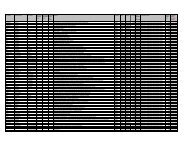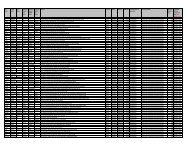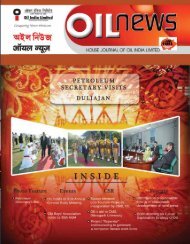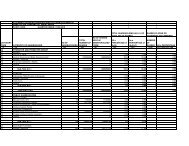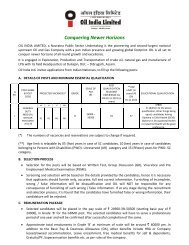2005 - Oil India Limited
2005 - Oil India Limited
2005 - Oil India Limited
You also want an ePaper? Increase the reach of your titles
YUMPU automatically turns print PDFs into web optimized ePapers that Google loves.
OIL beyond territorial barriers<br />
includes the contingent resources that may be currently<br />
un-economical or the discoveries whose commercial<br />
viability has not yet been determined as well as the value<br />
of the exploration prospects to be drilled by the company.<br />
It is needless to state while determining the asset value of<br />
the company that the risk-weighted values are to be taken<br />
into account.<br />
Against this background, E & P business is highly capital<br />
intensive. Moreover, the time required for exploration,<br />
appraisal of a discovery, development of fields considered<br />
as commercial and build-up of the surface facilities for<br />
production, processing, storage and transportation is<br />
usually very large as new large discoveries are likely to be<br />
located in hostile and far flung areas. By the time<br />
production from the new areas becomes available, the<br />
fields already in production would start to decline.<br />
Globally, the independent<br />
up-stream oil companies tend<br />
to generate internal growth<br />
in their value through<br />
acquisition of assets with<br />
core value and portfolio<br />
management through<br />
swapping of assets.<br />
M E R G E R S A N D<br />
ACQUISITIONS:<br />
PERSPECTIVES<br />
For growth of enterprise<br />
value, the oil companies would normally try to expand<br />
the business within the existing value chain, where<br />
adequate core competency exists. Moreover, in order to<br />
improve the bottom line, the down-stream companies<br />
would like to diversify into chemicals business and upstream<br />
business, where the return on capital are higher<br />
than in refining & marketing business .<br />
As the business dynamics of the petrochemicals business<br />
is comparable to that of the refining and marketing<br />
business, expansion of business of the down-stream<br />
companies by diversifying into the chemicals business<br />
comes naturally. However, the core competencies<br />
required for the E&P business are significantly different<br />
from those of the refining and marketing segment of the<br />
petroleum value chain. Therefore, the down-stream<br />
companies are eager to acquire an up-stream company to<br />
translate their expansion plans by migrating to a value<br />
chain with higher return potential.<br />
Various arguments are often put forward in favour of<br />
vertical integration of oil companies. Out of these, three<br />
important arguments are:<br />
• it would reduce volatility of earnings in the case of upstream<br />
companies.<br />
• it would improve security of supply in the case of<br />
down-stream companies.<br />
• it would improve utilization of logistics assets.<br />
Another reason as to why a refiner would seek vertical<br />
integration is that, integration could lower investment<br />
costs in refining by allowing refiners to optimize their<br />
operations around a known fixed crude oil system.<br />
While the securities of raw material<br />
supply in a process industry is very<br />
critical for its survival as a business entity.<br />
Volatility of crude oil price on an E & P<br />
company is not very critical as<br />
profitability of the company could be<br />
reasonably managed even at the time of<br />
low crude oil price by cutting down the<br />
exploration expenditure, and under<br />
special circumstances, by pruning<br />
development expenditures and shutting<br />
down the marginal fields. The temporary<br />
shortfall in crude availability from these<br />
measures would result in bounce back of<br />
the crude oil price. Utilization of logistics assets is true<br />
only in special cases. In any case, available infrastructures<br />
of different oil companies in the same area could be<br />
shared through contractual arrangements. It is quite<br />
common for the user to pay a tariff to the owner of such<br />
infrastructures if the same is cost-effective.<br />
If we look around the globe, we will find that most of the<br />
oil companies are either integrated oil companies or<br />
independent E & P oil companies. Accordingly, the<br />
Government of <strong>India</strong> started encouraging the downstream<br />
oil companies to move to up-stream activities in<br />
the 1990s. However, the results so far have not been very<br />
encouraging. This was not unexpected, as the downstream<br />
oil companies have tried to build up their own<br />
competencies in the complex up-stream business, which<br />
is time-consuming .<br />
4






